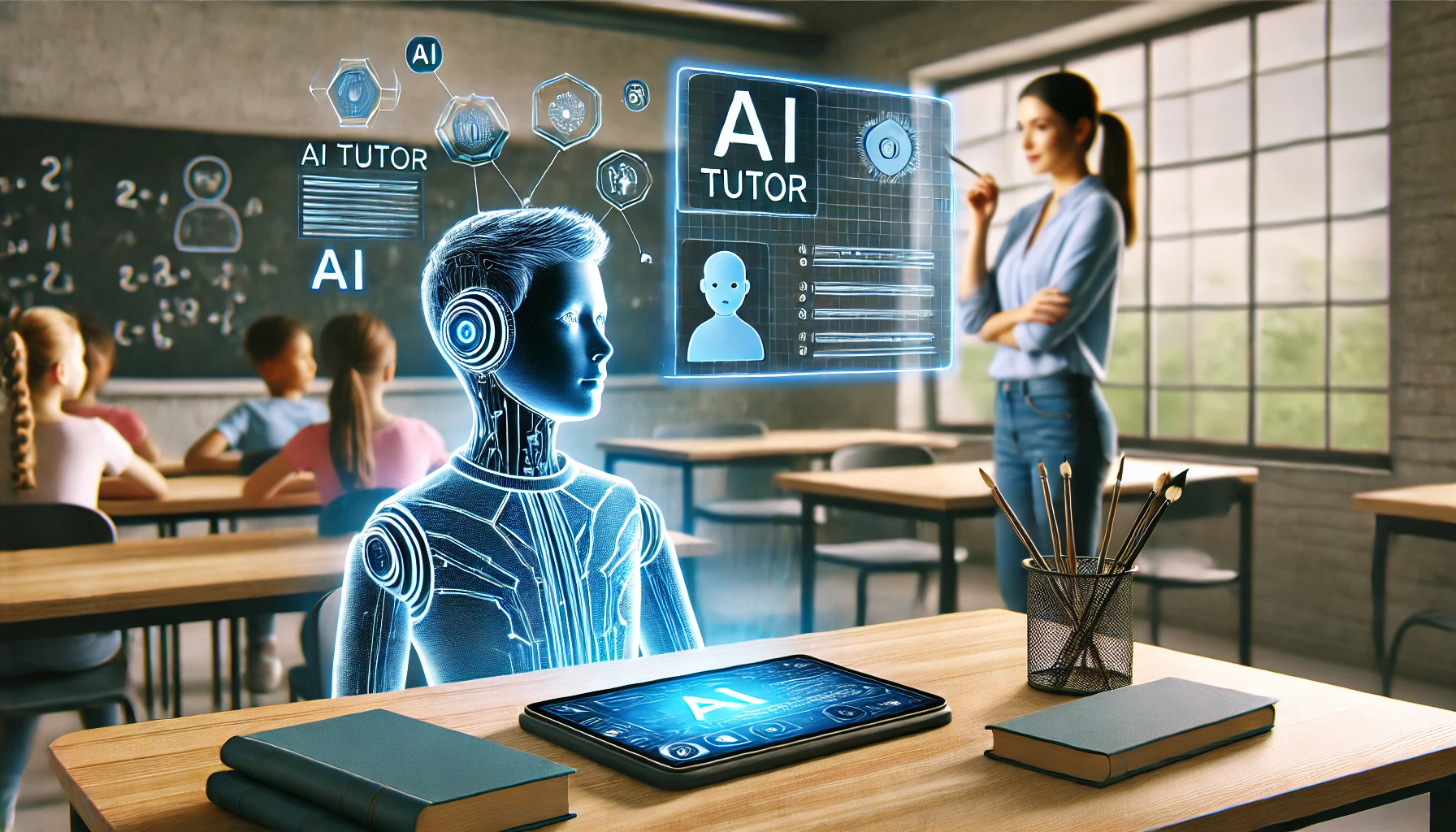Artificial Intelligence (AI) is transforming education in profound ways, creating learning experiences that adapt to individual needs, automating routine tasks for educators, and expanding access to quality education globally. From personalized learning paths to intelligent tutoring systems, AI-powered educational tools are reshaping how students learn and how teachers teach. In this article, we’ll explore the revolutionary impact of AI on education and what it means for the future of learning.

1. The Role of AI in Modern Education
Artificial intelligence is fundamentally changing the educational landscape by introducing capabilities that weren’t possible with traditional teaching methods. These intelligent systems can analyze student performance, adapt content delivery, and provide support precisely when and where it’s needed most.
AI enhances education in several transformative ways:
- Personalizing lessons to fit individual learning styles, paces, and preferences. AI systems analyze how each student learns best—whether through visual materials, hands-on activities, or text-based resources—and adjusts content delivery accordingly.
- Automating grading and assessments for teachers, freeing up valuable time that can be redirected to more meaningful educational activities like one-on-one coaching and curriculum development.
- Providing AI-powered tutoring for students that offers immediate feedback, answers questions, and provides additional explanations when concepts aren’t fully understood.
Professor Carlos Mendes from the University of São Paulo’s Education Technology Department explains: “Traditional educational models were designed for the average student—but there is no ‘average student’ in reality. Each learner has unique strengths, challenges, and interests. AI allows us to move from one-size-fits-all education to personalized learning experiences that maximize each student’s potential.”
Key Statistics: According to a 2024 study by the International Education Research Institute, students in AI-enhanced learning environments showed an average of 30% improvement in subject mastery compared to traditional classrooms, with the most significant gains seen among previously struggling students.
2. Best AI Tools for Smarter Learning
The educational technology landscape is rapidly evolving, with AI-powered tools addressing different aspects of the learning experience:
A. AI for Personalized Learning
Khan Academy AI Tutor has evolved significantly from its origins as a video-based learning platform. The system now incorporates sophisticated adaptive learning algorithms that analyze each student’s performance patterns, identifying knowledge gaps and learning preferences. Based on this analysis, it adjusts learning materials, pacing, and question difficulty in real-time.

What makes Khan Academy’s AI particularly effective is its ability to recognize when students are struggling with a concept and provide alternative explanations, example problems, or visual representations until mastery is achieved. The system also identifies when students are ready to advance to more challenging material, ensuring they remain engaged rather than bored.
Middle school teacher Ana Ferreira shares: “Khan Academy’s AI tutor has transformed how I approach differentiated instruction in my classroom. Students who master concepts quickly can move ahead while those who need additional support receive it automatically. The data I receive from the system helps me identify patterns across my classroom and adjust my teaching strategies accordingly.”
DreamBox AI has established itself as a leader in adaptive mathematics education. The platform uses AI to create individualized learning paths that adjust not just to whether students get answers correct or incorrect, but to the specific strategies they use to solve problems.
This deeper level of analysis allows DreamBox to identify conceptual misunderstandings and address them directly, rather than simply drilling students on procedures. The system offers multiple representations of mathematical concepts—visual, symbolic, and contextual—adapting to how each student learns most effectively.
“What’s revolutionary about adaptive learning platforms like DreamBox isn’t just that they adjust difficulty—it’s that they can recognize different cognitive approaches to problem-solving and support each student’s mathematical thinking. The system doesn’t just care if the answer is right; it cares about how the student thinks.”— Dr. Luisa Santos, Mathematics Education Researcher
B. AI for Writing and Research
Grammarly AI has evolved beyond simple spelling and grammar checking to become a comprehensive writing assistant. The system now provides context-specific writing suggestions, analyzes tone and clarity, and offers recommendations to improve engagement and readability.
For students, Grammarly serves as an always-available writing coach that helps develop stronger communication skills. The most recent version can provide feedback on structural elements of academic writing, including thesis statement clarity, evidence usage, and logical flow of arguments.
University writing instructor Rafael Oliveira notes: “Grammarly AI doesn’t just correct errors—it teaches principles of effective writing. I encourage my students to use it as a learning tool, not just a proofreader. The specific, actionable feedback it provides helps students understand why certain changes improve their writing, which leads to genuine skill development over time.”
QuillBot AI represents a significant advancement in paraphrasing and writing enhancement technology. Using sophisticated natural language processing, the system can rephrase text while maintaining the original meaning, adjust formality levels, and suggest alternative vocabulary.
For research and essay writing, QuillBot helps students process and synthesize information from source materials without direct copying. The tool also includes a summarization feature that can distill lengthy articles into key points, helping students with reading comprehension and information processing.
Ethical Consideration: Educators are developing new approaches to teaching responsible use of AI writing tools like QuillBot. Rather than banning these technologies, many institutions now focus on teaching students to use them as research aids and writing assistants while maintaining academic integrity through proper attribution and original thinking.
C. AI in Virtual Classrooms
Google Classroom AI Tools have transformed the online learning experience by automating many administrative aspects of education. The platform now includes intelligent features that can grade certain types of assignments automatically, generate personalized feedback based on common error patterns, and even detect potential plagiarism.
The system also provides teachers with insights about class performance, identifying concepts that many students find challenging and suggesting supplemental resources to address these knowledge gaps.
High school teacher Paulo Mendes explains: “Google Classroom’s AI tools have reduced my administrative workload by at least 40%, giving me more time to focus on actual teaching. The system handles routine grading and even suggests differentiated assignments based on student performance data. This allows me to provide more personalized attention to students who need additional support.”
Edmodo AI has evolved into an intelligent educational ecosystem that connects students, teachers, and educational resources. The platform’s recommendation engine analyzes each student’s learning patterns, interests, and performance to suggest relevant educational content from its vast library of resources.
What makes Edmodo particularly valuable is its ability to facilitate collaborative learning through AI-moderated discussion groups that ensure balanced participation and productive conversation. The system can identify when discussions go off-track and suggest prompts or resources to refocus learning.

3. AI and Accessibility in Education
Artificial intelligence is playing a crucial role in making education more accessible to students with diverse needs and abilities:
AI-powered text-to-speech tools have advanced significantly in natural-sounding voice synthesis, making digital content accessible to students with visual impairments or reading difficulties. Modern systems like Microsoft’s Immersive Reader can now adjust reading speed based on content complexity, emphasize structural elements like headings, and even provide visual cues alongside narration to enhance comprehension.
Special education teacher Marina Costa shares: “Text-to-speech technologies have transformed learning for my students with dyslexia and visual processing challenges. The AI doesn’t just read text aloud—it can highlight words as they’re spoken, adjust pacing for complex passages, and even explain challenging vocabulary in context. This comprehensive support helps students build independence rather than just providing accommodation.”
AI-driven language translation has made multilingual education more accessible than ever. Real-time translation tools like Google Translate’s AI have improved dramatically in accuracy and now support over 130 languages, including many indigenous and less commonly taught languages.
These technologies are particularly valuable for immigrant students, international education programs, and language learning contexts. Advanced features now include domain-specific vocabulary for academic subjects, ensuring translations maintain the precise meaning of technical terms in mathematics, science, and other fields.
ESL coordinator João Silva explains: “AI translation tools have completely changed how we support multilingual students. We can now provide learning materials in a student’s native language while they develop English proficiency, ensuring they don’t fall behind in subject knowledge. The latest systems even understand academic context, translating scientific and mathematical concepts accurately rather than literally.”
AI-enhanced adaptive learning platforms are creating new possibilities for students with diverse learning needs. These systems can adjust not just content but also interface design, presentation methods, and interaction approaches based on individual requirements.
For students with attention disorders, content might be presented in smaller chunks with more frequent interactive elements. For those with motor control challenges, alternative input methods might be emphasized. Students with processing difficulties might receive the same content with additional visual supports or simplified language.
“The most powerful aspect of AI in special education is its ability to provide differentiated support without segregating students. Everyone can work on the same curriculum, with the technology subtly adjusting how content is presented and how students demonstrate knowledge based on individual needs.”— Dr. Carolina Oliveira, Inclusive Education Specialist
4. The Future of AI in Education
As AI technology continues to evolve, several transformative developments are on the horizon:
A. Virtual Education Companions
AI-powered virtual teachers represent perhaps the most ambitious frontier in educational technology. These systems go beyond simple tutoring to provide comprehensive educational experiences that adapt to individual students.
Advanced virtual teachers combine natural language processing, emotion recognition, and deep subject knowledge to create interactive learning experiences that respond to student questions, misconceptions, and emotional states. While not replacing human educators, these systems can provide supplemental instruction, practice opportunities, and personalized guidance beyond regular classroom hours.
Educational technologist Dr. Paulo Santos explains: “The next generation of AI educational companions will understand not just what students know, but how they feel about learning. By recognizing frustration, boredom, or confusion through facial expressions and interaction patterns, these systems can adjust their approach in real-time—slowing down, providing encouragement, or changing examples to maintain engagement.”
Emerging Development: Researchers at the Federal University of Rio de Janeiro are developing AI teachers that can adapt their communication style to match students’ cultural backgrounds and personal learning preferences, making educational interactions feel more natural and relatable.
B. Predictive Educational Analytics
AI-driven predictive analytics are revolutionizing how educational institutions identify and support students at risk of falling behind. These systems analyze multiple data points—including assignment completion patterns, engagement metrics, attendance, and performance trends—to identify early warning signs of academic struggle.

What makes these systems particularly valuable is their ability to identify specific intervention opportunities rather than simply flagging struggling students. The AI might determine that a student needs additional support with particular concepts, would benefit from alternative learning materials, or requires more frequent feedback to maintain progress.
School administrator Carlos Mendez shares: “Predictive analytics have transformed our approach to student support. Instead of reacting when students are already failing, we can proactively provide resources when the first signs of difficulty appear. The AI helps us identify not just who needs help, but what kind of help would be most effective based on their specific challenges.”
C. Immersive Learning Environments
AI-enhanced immersive learning using augmented and virtual reality represents one of the most exciting developments in educational technology. These systems combine spatial computing with artificial intelligence to create interactive learning environments that adapt to student actions and learning needs.
In science education, students might explore virtual ecosystems where AI controls the behavior of organisms based on environmental changes. In history classes, intelligent virtual characters might represent historical figures, engaging students in conversations that adjust based on student questions and interests.
Education researcher Maria Silva explains: “Immersive learning environments powered by AI can create experiences that would be impossible in traditional classrooms. Students can witness historical events, manipulate molecular structures, or practice real-world skills in safe, adaptive environments. The AI ensures these experiences respond meaningfully to student actions and adjust complexity based on demonstrated understanding.”
5. Challenges and Ethical Considerations
The integration of AI in education presents important challenges that must be addressed:
- Equity and access: Ensuring that AI educational tools are available to all students, regardless of socioeconomic status or geographic location.
- Privacy and data protection: Establishing clear guidelines for how student data is collected, used, and protected in AI-powered learning systems.
- Human connection: Maintaining meaningful human relationships in education while leveraging AI for appropriate tasks.
- AI literacy: Developing students’ and educators’ understanding of how AI works, its limitations, and how to use it responsibly.
- Technological dependence: Ensuring students develop fundamental skills and knowledge rather than becoming overly reliant on AI assistance.
Education policy expert Dr. Luisa Ferreira emphasizes: “As we implement AI in education, we must be guided by clear pedagogical goals rather than technological novelty. The question shouldn’t be ‘How can we use AI?’ but rather ‘How can AI help us create more effective, equitable, and engaging learning experiences?’ Technology should serve educational values, not define them.”
Conclusion: Reimagining Education for the AI Era
AI is making education smarter, more personalized, and accessible to all. By automating routine tasks, providing adaptive learning experiences, and offering insights that would be impossible to gather manually, these technologies are helping educators focus on what matters most: guiding, inspiring, and connecting with students.
The most promising aspect of AI in education isn’t the replacement of traditional teaching but its enhancement. Technology handles the tasks that machines do best—analyzing data, remembering details, and performing repetitive functions—while human educators focus on what they do best: providing wisdom, emotional support, ethical guidance, and creative inspiration.
For students, teachers, and administrators alike, AI-powered educational tools offer unprecedented opportunities to transform learning. The result isn’t just more efficient education—it’s more effective, engaging, and equitable learning experiences that prepare students for a future where human creativity and technological capability must work hand in hand.
Getting Started: If you’re interested in exploring AI educational tools, begin with platforms that address specific needs in your learning or teaching context. Many tools like Khan Academy, Grammarly, and Google Classroom offer free versions that provide excellent entry points for experiencing the benefits of AI in education.
Embrace AI in education today and experience the future of smarter learning!
How do you see AI changing education in your context? Share your experiences or questions in the comments below.
References and Further Reading
- International Education Research Institute. (2024). The Impact of Adaptive Learning Technologies on Student Achievement. Annual Education Technology Review, 18(2), 45-67.
- Mendes, C., & Ferreira, L. (2023). Artificial Intelligence in Brazilian Classrooms: Implementation Strategies and Outcomes. Journal of Educational Technology in Latin America, 15(3), 112-129.
- Santos, P., & Oliveira, C. (2024). Virtual Teachers and Educational Companions: The Next Generation of AI in Learning. International Journal of Educational Technology, 12(1), 78-94.
- Google Education Research. (2024). AI-Enhanced Classroom Analytics: Supporting Teacher Decision Making. Google Education Publications.
- Silva, M., & Costa, M. (2023). Immersive Learning Environments: Combining AR/VR with Artificial Intelligence for Enhanced Science Education. Science Education Technology Journal, 31(2), 156-172.
- Microsoft Education. (2024). Accessible Learning for All: How AI is Removing Barriers in Education. Microsoft Research Publications.
- Federal University of Rio de Janeiro. (2024). Culturally Responsive AI Teaching Assistants: Research Findings and Implementation. UFRJ Educational Technology Research Series.
- Ferreira, L., & Mendez, C. (2024). Ethical Framework for AI in Educational Contexts. Journal of Education Ethics and Technology, 8(4), 203-219.

